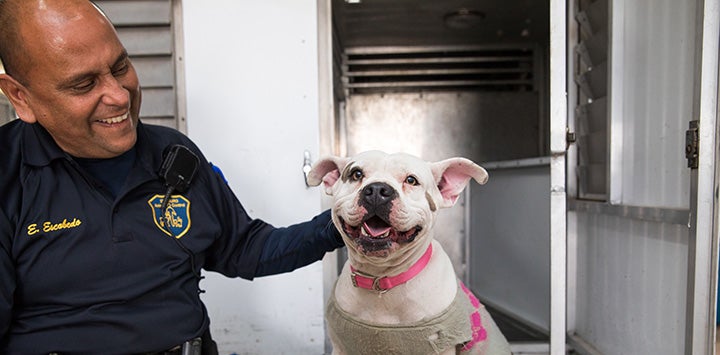
Field-Training Programs Playbook
Introduction
Field-training programs are used to instruct new animal control officers (often referred to as recruits) in the various duties that they will most likely perform during their professional careers.
A well-developed and executed field-training program is innovative and proactive. It promotes and develops a recruit’s knowledge of an animal control officer’s duties and skills. It is a critical engagement and educational process that gives recruits the knowledge and guidelines they need to perform competently as an animal control officer in the field. Historically, recruits have been trained solely by participating in ride-alongs with seasoned officers, which lacks formality in the learning process and does not set them or their agencies up for success.
Field-training programs provide agencies with departmental consistency in, for example, the execution of safe and humane animal handling, officer safety and ordinance enforcement.
Program Overview
Creating a training manual that encompasses all aspects of your field-training program (that recruits can carry with them) will provide your agency with a valuable resource that is not only educational but greatly contributes to accountability and performance measurement. Consistency is critical, as it instills confidence in officers, promotes trust within and builds relationships with the community, and increases community engagement while upholding the law and protecting public safety.
Not every training situation is covered in this operational playbook, but the points listed in the training manual summary are a good starting point. The training points encompass basic departmental information, community ordinances and state legislation, and required critical in-field and out-of-field skills to help new officers build a good foundation for their careers and future professional activities.
Field-training officers should be carefully selected and trained themselves to be able to perform on-the-job training. Selection should not be based on tenure, but rather on demonstrated leadership skills, knowledge, and the ability to share information and teach recruits in a competent manner.
Some states mandate state-approved certification and continuing education credits for animal control officers. If your state does not require ongoing training, we recommend that you consider requiring your officers to accrue a certain number of training hours per year for the purposes of professional development and knowledge of current best practices. This requirement can be included as part of annual performance evaluations.
Program Composition
The following describes workforce needs, internal and/or external resources, and any other additional steps that should be taken into consideration for successful program implementation:
- Create a field-training officer job description: Work with the necessary city or county departments to create a job description and, if possible, start a discussion about a potential salary increase.
- Identify a qualified field-training officer: Once a field-training officer has been identified, collaborate with your local police department to offer that person cross-training. Many police departments will allow animal control officers to audit their classes.
- Create a field-training program timeline: Decide how long each training phase will last, and which training points will be covered in each phase.
- Create testing procedures: Decide how you would like to evaluate recruits during each training phase (written, oral, observation). A combination of the three is highly recommended. This should include a discussion about what the steps are if a recruit does not achieve satisfactory testing and performance results (including, but not limited to, retraining and termination if necessary).
- Create necessary checklists and forms: Examples include (but are not limited to) equipment checklist, field-training checklist, field report log, daily observation report, weekly observation report, recommendation report, remedial training worksheet, training and orientation phase summary.
- Identify necessary resources: Some examples are training space for classroom work, resources for printed materials, and external training resources applicable to your program (e.g., webinars and trainings from the National Animal Care & Control Association, ASPCA Pro, Maddie’s Fund, Humane Society of the United States, Best Friends).
- Create a field-training and evaluation program manual: The resources below contain an example of a training manual summary and full information on two agencies’ field-training programs.
Conclusion
Field-training programs can be used as an evaluation and selection process to staff your department and community with officers who can perform their job duties humanely, safely and efficiently. Well-developed and informed officers and their animal control programs uphold and enhance public safely, cultivate positive relationships with their communities, and promote the human-animal bond.
Now that you have a general understanding of developing a field-training program, the following documents may act as templates as you implement one of these programs in your own agency. Keep in mind that there is no perfect form of implementation. Using the considerations and program composition notes above, you should use the following only as building blocks when creating your own standard operating procedures, field-training and evaluation program, or documents (both internal and public). Should you need further assistance or clarification, please do not hesitate to reach out to your regional strategist, regional director, or the Best Friends national shelter support team at fieldservices@bestfriends.org.
Resources
- Hillsboro County’s Field Training Program (Tampa, Florida)
- Pima Animal Care Center’s Field Training Program (Tucson, Arizona)
- DeKalb County’s Field Training Program (Chamblee, Georgia)
- Humane Educators of Texas’ Field Training Program (templates)
- Best Friends Animal Society’s Humane Animal Control Manual
- Field Training and Evaluation Manual summary example
Updated May 2022
If you found this playbook helpful, check out our full catalog of handbooks, manuals, and playbooks.